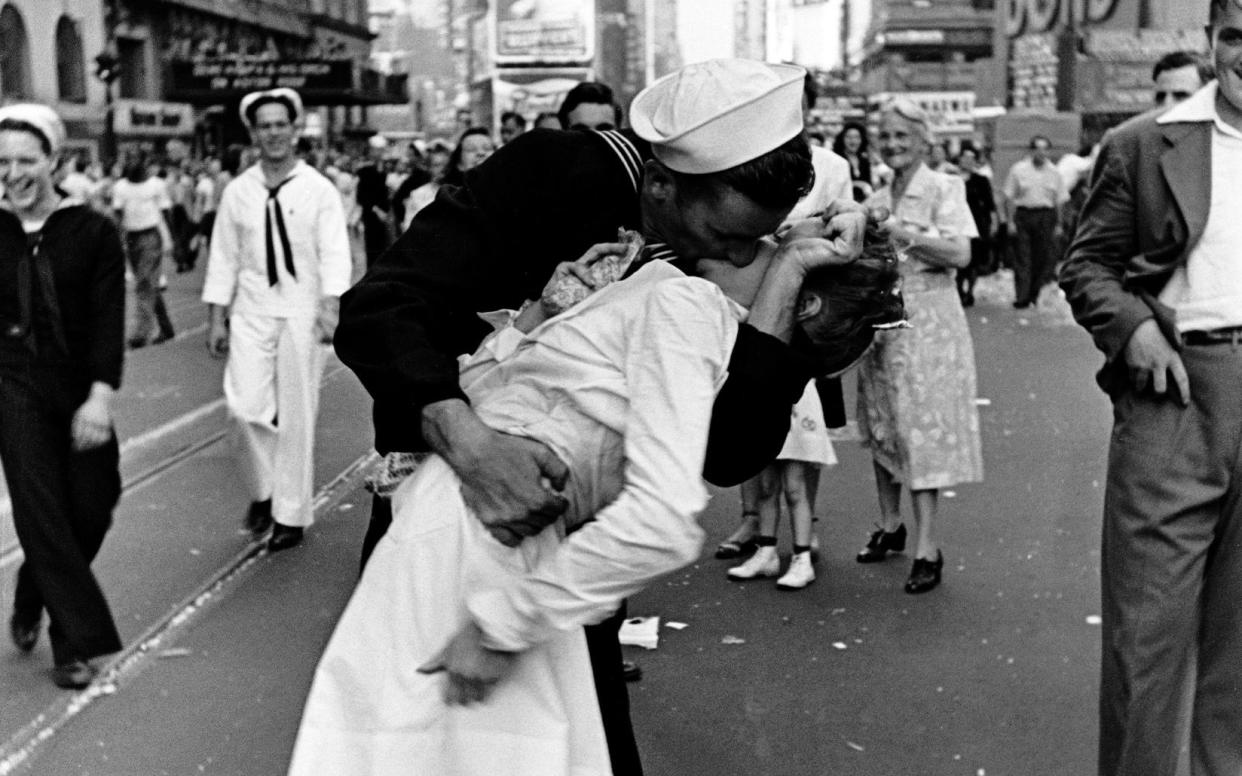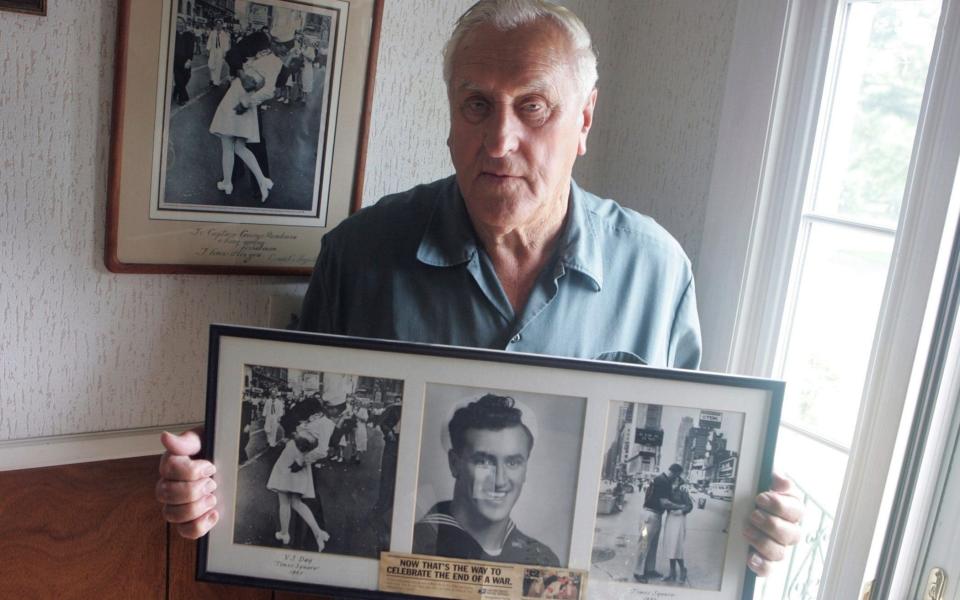How the hunt to find VJ Day's mystery kissers sparked an uncomfortable debate about consent

On the afternoon of 14th August 1945, Alfred Eisenstaedt was strolling around New York City, observing a country in a state of jubilation. The Allied victory over the Japanese empire was about to be confirmed and Eisenstaedt, a renowned photojournalist, had been told to take a snapshot to capture that momentous day for the readers of Life magazine.
At 5.51pm, in Times Square, he noticed a tall, dark-haired man in a sailor’s uniform swooping in on a nurse dressed in white. To the delight of onlookers, he planted a theatrical kiss on her lips. Eisenstaedt aimed his Leica camera and took four snaps - all he could manage in the few seconds before they separated. Amid the hubbub, he was unable to take down their names.
The photograph - now known as ‘VJ Day in Times Square’ - was printed on a full-page in Life a week later, and has since become one of the most recognisable images in history, reproduced on countless posters and fridge magnets. It has come to define a nation at its most triumphant, when America stood on the cusp of an era of unbridled postwar optimism. It also sparked a remarkable hunt to uncover the identities of Eisenstaedt’s subjects, a mystery that was only truly put to bed eight years ago - and, more recently, has ignited an uncomfortable debate over whether the sailor’s non-consensual kiss actually signifies something darker.
“What a great way to end the war, in Times Square, at the cross-streets of the world,” Lawrence Verria - a history teacher who became fascinated with the picture and eventually uncovered the identities of both the sailor and the nurse in his book, The Kissing Sailor - told me this week. “There’s spirit and energy in that photo.”
At moments of great historical significance, it is often the photographs we remember. A distraught Vietnamese girl fleeing a napalm attack; a London milkman in 1940 climbing over the rubble of the previous night’s bombing to deliver his produce as normal; a young man with shopping bags blocking Chinese tanks from entering Tiananmen Square; an office worker falling gracefully and tragically from the burning World Trade Centre - each of these images come to mind easily, and in each case historians have gone to great lengths to identify the people in the photo.
In the case of Eisenstaedt’s kissing sailor, that took at least six decades, and the task was left largely to hobby historians like Verria.

In 1980, Life published an appeal to find the mystery sailor, “which opened the floodgates”, according to Verria’s book; of those who wrote in, 11 were deemed by the magazine as credible. Then, in the 2010s, he conducted the first rigorous investigation, enlisting his country’s top experts, including Dr Norman Sauer, a forensic anthropologist at Michigan State University, to make painstaking records of each man’s stature, hairline, tattoos, and cheekbones.
After visually enhancing the photos and interviewing the candidates, he found there was one man for whom evidence of a match was “overwhelming”: George Mendonsa, from Rhode Island, who enlisted in the Navy months after Pearl Harbour and was steering a destroyer in the Pacific in 1945 when it was sunk by kamikaze fighters. He helped more than 100 sailors reach safety, and was touched to see nurses caring for the wounded.
“I believe from that day on I had a soft spot for nurses,” he said in a 2005 interview, explaining his spontaneous decision to embrace an unknown nurse on VJ Day. Mendonsa was so confident that he sued Life for not naming him conclusively as the sailor (the case went nowhere).
“I can’t see anyone who would look over the evidence and come to any other conclusion,” says Verria. “This includes a bump on his left arm, which we can see in the sailor’s picture. You can also vaguely see a G and M on his arm.”
But the nurse proved far trickier to find, simply because there is less of her in the photo. For many years, it was wrongly thought to be Edith Shane, from California, who wrote to Eisenstaedt in 1979 claiming that she recognised herself in the picture as early as the Forties, but did not come forward because it made her look unladylike. After a fairly unscientific glance at her legs, Eisenstaedt accepted her story; and eager for a scoop, Life declared they had found the nurse at last. Shain toured the country delivering after-dinner speeches until her death in 2010, and in 2007 was even recognised by President George Bush as a symbol of world peace.
But Verria was unconvinced. “There was a rush for judgment. The more I looked into the evidence, it became clear this was not the woman in this photo. Shane didn’t match up height-wise with Mendonsa, and she was more full-bodied than the woman in the photo - that woman is very slender. She couldn’t come up with a single picture with her hair tied up the way it was in the photo.”
It is not that Shane was lying or trying to seek attention, Verria says. Records suggest there was a great deal of spontaneous kissing in New York that day; Shane was probably embraced by another man, and thought it was her in the photograph. The same goes for most of the men who claimed to be the sailor, he adds.
Instead, Verria says the proof points strongly towards an alternative candidate: Greta Friedman, who wrote to Life claiming to be the nurse a few years after Shane. Having fled Austria in 1939 as a Jewish refugee, Friedman worked as a dental hygienist just a few blocks from Times Square, and remembers being kissed by a sailor that evening after leaving work to investigate the commotion. Her height and body composition match “perfectly”, Verria says, and contemporary photos show she had the right hairstyle.
“I admit the evidence supporting her is not as great as the evidence supporting the sailor,” says Verria. “[But] everything we have points directly to her. We have no other candidates who match up nearly as well.”

Friedman died in 2016. Speaking this week from Virginia, her son Joshua described her as an avid painter and theatregoer who was quite coincidentally fascinated with photojournalism, particularly Henri Cartier-Bresson’s haunting images of concentration camps. Her unsought fame was little more, he remembers, than a “fun anecdote” to tell at parties.
“It was nothing she caused or created, I think she gave the photographer credit for creating something memorable, and she thought it was just a coincidence that it happened to her,” says Friedman, 60, who puts on his Christmas tree every year an ornament emblazoned with Eisenstaedt’s picture.
Surprising, perhaps, given that the photo has now taken darker connotations. Friedman was always clear that she did not invite the kiss, and did not particularly enjoy it.
“It wasn’t my choice to be kissed,” she said in a 2005 interview, and then in 2012. “I did not see him approaching, and before I know it I was in this tight grip.”
Amid the MeToo movement, feminist writers now say the photograph depicts a disturbingly casual assault - a relic from an era in which men were free to grab and kiss women with few consequences. Shortly after Mendonsa’s death last year, a statue in Florida commemorating the encounter was vandalised with red ‘Me Too’ graffiti.
But, confusingly, Friedman was also clear that she did not regard the kiss as an assault; she even reunited with Mendonsa in her later years, and the pair remained friends until their deaths.
“She was still alive when that conversation took place,” remembers her son. “She was very sympathetic to a feminist interpretation, but she just thought it wasn’t the whole story. She was 21, he was 22, they were celebrating. She’d lost a large part of her family at the beginning of the war. It was just a very unique time - you can’t always apply today’s rules.”
For her, Friedman says, the “most important thing was the war was over” - a feeling shared across the world on that jubilant summer’s evening.
Lawrence Verria's The Kissing Sailor: The Mystery Behind the Photo That Ended World War II (2012) is published by the Naval Institute Press for £15.99


